
A crane fly is any member of the dipteran superfamily Tipuloidea, which contains the living families Cylindrotomidae, Limoniidae, Pediciidae and Tipulidae, as well as several extinct families. "Winter crane flies", members of the family Trichoceridae, are sufficiently different from the typical crane flies of Tipuloidea to be excluded from the superfamily Tipuloidea, and are placed as their sister group within Tipulomorpha.

Limoniidae is the largest of four crane fly families, with more than 10,700 species in more than 150 genera. Some studies have suggested it to be a paraphyletic group, with some limoniids being more closely related to Tipulidae and Cylindrotomidae than to other limoniids. Limoniid crane flies can usually be distinguished by the way the wings are held at rest. Limoniids usually hold/fold the wings along the back of the body, whereas other crane flies usually hold them out at right angles. Snow flies such as Chionea scita have no wings at all. Limoniids are also usually smaller than other crane flies, with some exceptions.

The Pediciidae or hairy-eyed craneflies are a family of flies closely related to true crane flies, with about 500 species worldwide.
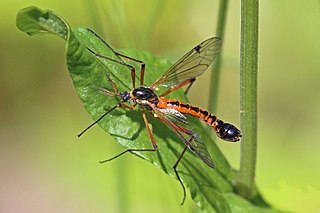
Tanyptera is a genus of true crane flies; its species are lustrous and black and yellow or red in color. They resemble some Ichneumonidae. Segments of the flagella of males have three outgrowths each. The antennae of the females are distinctly 13-segmented. The sides of the mesothorax are glabrous. The ovipositor of the female is unusually long, the valves being only slightly shorter than the cerci. Tanyptera spp. exhibit extreme polymorphism in the body colour and body size of the sexes. The wing colors also vary from smoky-black, brown, or brownish-yellow, to transparent.

Sabatinca lucilia is a species of moth in the family Micropterigidae. It is endemic to New Zealand and is found in the top half of the North Island. The adults of this species are on the wing from the end of November until the beginning of March. The larvae of this species likely feed on foliose liverwort species with the adults likely feeding on fern spores or sedge pollen. Adults have been found on a sunny moss-covered clay bank. The species can be found in multiple forest types such as kauri, kanuka and Nothofagus and prefers to inhabit damp fern covered banks

Izatha prasophyta is a moth of the family Oecophoridae. It is endemic to New Zealand, where it is known from the North Island, except Hawkes Bay or the Wairarapa. Larvae likely feed on rotting wood although larvae of this species have been reared on the fruiting body of the bracket fungus Bjerkandera adusta. Adults are on the wing from November to February.
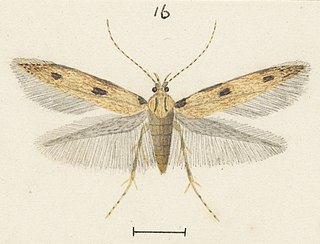
Labdia anarithma is a moth of the family Cosmopterigidae. It was described by Edward Meyrick in 1888. It is found in New Zealand and throughout Australia. Adults are on the wing from December to March and are day flying. They have been collected by sweeping bracken fern.
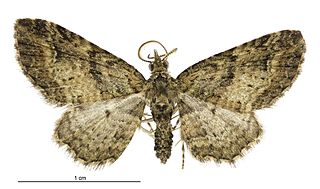
Pasiphila charybdis is a species of moth in the family Geometridae. It is endemic to New Zealand.

Apoctena taipana is a species of moth of the family Tortricidae. It is endemic to New Zealand and has been observed in both the North and South Islands. The larvae created a silken tube in which they hide and also use to travel from leaf to leaf. They tunnel into the leaves of their host. Larvae can be found from June to August. Adult moths can be seen on the wing from October to January.

Epichorista aspistana is a species of moth of the family Tortricidae. It is endemic to New Zealand and has been collected in Canterbury and Otago. This species inhabits moist grassy areas at altitudes ranging from sea level to 1650m. Larvae feed on species within the genus Acaena. Adults are on the wing in November to February.
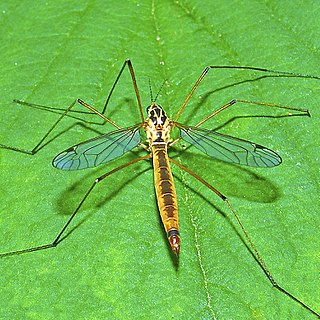
Nephrotoma cornicina is a species of fly in the family Tipulidae.

Physetica temperata is a species of moth of the family Noctuidae. It is endemic to New Zealand and found in the North Island and the top of the South Island in coastal areas. P. temperata is unlikely to be confused with other species in its range, even though it is not distinctively patterned. It is possible that males might be confused with males of P. homoscia but this latter species is much larger. P. temperata can be distinguished from P. caerulea as the former species has forewing veins that are marked black and a chequered forewing fringe. The adults of this species are on the wing from September to March. The life history of this species has not been well documented although it is thought that larval host species is Ozothamnus leptophyllus.

Tingena anaema is a species of moth in the family Oecophoridae. It is endemic to New Zealand and has been collected at Lake Wakatipu, Invercargill and Stewart Island / Rakiura. The adults of the species are on the wing in December.

Tingena chrysogramma is a species of moth in the family Oecophoridae. It is endemic to New Zealand and is found in the North and South Islands. The adults of this species inhabits open scrubland and are on the wing in January and February. It has been collected via light traps and beating shrubs. During sunny days this species has been observed resting on leaves and rarely flies. It is regarded as a rare species and has a possible association with Prumnopitys ferruginea.

Tingena idiogama is a species of moth in the family Oecophoridae. It is endemic to New Zealand and has been observed on the slopes of Mount Taranaki. Its preferred habitat is native subalpine scrub and adults are on the wing in January.

Tingena letharga is a species of moth in the family Oecophoridae. It is endemic to New Zealand and has been observed in Otago. Adults are on the wing in December and January.
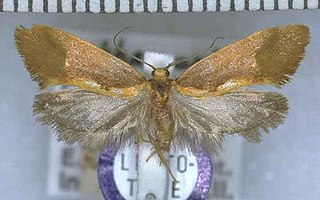
Tingena phegophylla is a species of moth in the family Oecophoridae. It is endemic to New Zealand and has been observed in the southern parts of the South Island. This species inhabits native beech forest. The adults of this species are on the wing in December.

Leptotarsus albistigma is a species of crane fly native to New Zealand. The species was first described as Macromastix albistigma by Frederick Wallace Edwards in 1923.

Sylvicola notatus, also known by the common name outhouse fly, is a species of wood gnat in the family Sylvicola. It is endemic to New Zealand.

Amphineurus hudsoni is a species of crane fly native to New Zealand. The species was first described by Frederick Wallace Edwards in 1923.




















